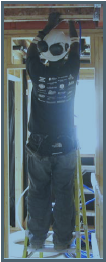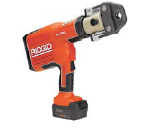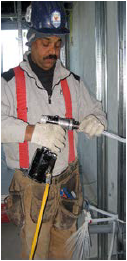The problem: Manual crimping
- Plastic pipe (PEX) tubing is being widely used in plumbing and radiant floor heating.
- To install the tubing, plumbers use metal rings to secure plastic pipes onto fittings. The rings are squeezed or crimped using a one- or two-hand manual crimping tool.
- Manual crimping tools require a high level of grip force which may expose workers to risk of injury.
- The crimping process may be repeated hundreds of times a day and with awkward postures.
Solution one: Powered crimping tools
- Use battery-powered crimpers to complete the joints.
- This work process will eliminate the high physical demand associated with the excessive grip force of manual crimping.
Benefits of the powered crimping tools
- Powered crimpers eliminate the excessive grip force required when manually crimping and thus reduce the risk of injury associated with this task.
Potential drawbacks of powered crimping tools
- The use of the powered crimper in tight and awkward places, such as between 2x4’s in the frame of a home, is difficult due to their size.
- The physical weight of the tool is also a concern, especially when making connections in awkward locations with arms raised overhead.

Traditional method of manually crimping pipes.

Manual crimping tool

>Powered crimping tool
Solution two: Stretchable pipe system
- A new plastic pipe system relies on plastic ‘memory’ and eliminates the need for crimping entirely.
- There are powered tools available that stretch the tubing prior to insertion onto a fitting.

A pneumatic (left photo), and batter-powered (right photo) stretchable pipe tool used for making plastic pipe connections in the plumbing trade.
How it works
- The plastic pipe and plastic rings are stretched with a powered tool and then a fitting is inserted into them.
- As the stretched tubes and rings return to their original size, they clamp down on the fitting and a connection is completed.

Operating powered tool
Benefits of the stretchable pipe system
- Powered tools reduce the forceful exertions associated with the manual tools.
- Stretching of the ‘stretchable’ system can occur in more neutral postures (e.g. waist level) directly in front of the plumber.
- This reduces awkward shoulder postures and overhead work.
- The task is easier because the plumber does not have to reach around obstructions that are overhead.
- The reduction of awkward postures and high grip force can reduce the risk of injury to the neck, shoulders, arms, and hands.
- The stretchable pipe system decreases the number of failed joints.
Potential drawbacks of stretchable pipe system
- The weight of the battery powered stretching tools is a concern.
- The use of this tool at waist level can minimize the stress on the shoulder joint.
- Because the stretchable tool can be used at waist level it is possible to have a balancer or cart available for the tool between uses.
- The stretchable tubes and rings are affected by the ambient temperature. As the ambient temperature decreases below 10°C, the plastic stretchable tubing and rings becomes more rigid which requires workers to hold them in place longer on the fitting while they return to size to complete the connection.
- As a result, during the connection, workers can potentially be exposed to long periods of awkward postures.
- Holding the tubes and fitting in place longer during cold weather may also result in less productivity.
- The physical demand associated with this, however, is generally quite low as the pipes are simply held in place.
- Stretching systems may increase the amount of time required to complete a joint.
Solution three: Alternative system to Crimping and Stretching: Push fittings
- Push fittings, designed for both copper and PEX piping, eliminate the need for heavy tools and high physical demand.
- The fittings of the system are designed to allow the insertion of any type of pipe to complete the connection.
- The plumber inserts the end of the pipe into the fitting which clicks to indicate that a connection has been made.
- The pipe can be released using a small plastic ring, and then the fittings reused.
- This system eliminates the majority of the physical demands associated with manual crimping/stretching and the use of heavy powered tools.
Potential Drawbacks of alternative system
- Awkward postures may still be necessary to complete connections in some areas. The time spent in these postures may be reduced because of the quick ‘biting’ action of the fittings when making a connection.
- The cost of the fittings for this system is higher than that for both the stretching and crimping systems.
For more information
- Products related to this solution are described at the Centre for Construction Research and Training (CPWR).
- Products may also be found on the internet using the following search terms: “crimping tools”, “PEX tools”, and “plumbing push fittings."
- Local contractor tool and equipment suppliers or rental companies may be another source of information on products.
- For general information on this solution, call the Infrastructure Health & Safety Association at 416-674-2726 or 1-800-781-2726.